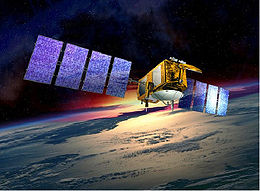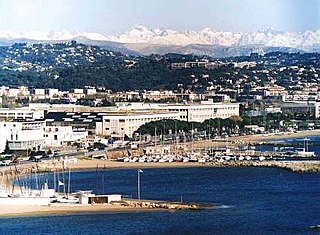
The European Organisation for the Exploitation of Meteorological Satellites (EUMETSAT) is an intergovernmental organisation created through an international convention agreed by a current total of 30 European Member States: Austria, Belgium, Bulgaria, Croatia, the Czech Republic, Denmark, Estonia, Finland, France, Germany, Greece, Hungary, Ireland, Iceland, Italy, Latvia, Lithuania, Luxembourg, the Netherlands, Norway, Poland, Portugal, Romania, Slovakia, Slovenia, Spain, Sweden, Switzerland, Turkey, and the United Kingdom. These States fund the EUMETSAT programs and are the principal users of the systems. The convention establishing EUMETSAT was opened for signature in 1983 and entered into force on 19 June 1986.

Satellite geodesy is geodesy by means of artificial satellites — the measurement of the form and dimensions of Earth, the location of objects on its surface and the figure of the Earth's gravity field by means of artificial satellite techniques. It belongs to the broader field of space geodesy. Traditional astronomical geodesy is not commonly considered a part of satellite geodesy, although there is considerable overlap between the techniques.

Space-based radar refers to space-borne radar systems that may have any of a variety of purposes. A number of earth-observing radar satellites, such as RADARSAT, have employed synthetic aperture radar (SAR) to obtain terrain and land-cover information about the Earth.

Argos is a satellite-based system which collects, processes and disseminates environmental data from fixed and mobile platforms worldwide. What makes Argos unique is the ability to clearly geographically locate the source of the data anywhere on the Earth utilizing the Doppler effect.

Seasat was the first Earth-orbiting satellite designed for remote sensing of the Earth's oceans and had on board the first spaceborne synthetic aperture radar (SAR). The mission was designed to demonstrate the feasibility of global satellite monitoring of oceanographic phenomena and to help determine the requirements for an operational ocean remote sensing satellite system. Specific objectives were to collect data on sea-surface winds, sea-surface temperatures, wave heights, internal waves, atmospheric water, sea ice features and ocean topography. Seasat was managed by NASA's Jet Propulsion Laboratory and was launched on 27 June 1978 into a nearly circular 800 km orbit with an inclination of 108°. Seasat operated for 106 days until 10 October 1978, when a massive short circuit in the satellite's electrical system ended the mission.

MetOp is a series of three polar orbiting meteorological satellites developed by the European Space Agency (ESA) and operated by the European Organization for the Exploitation of Meteorological Satellites (EUMETSAT). The satellites form the space segment component of the overall EUMETSAT Polar System (EPS), which in turn is the European half of the EUMETSAT/NOAA Initial Joint Polar System (IJPS). The satellites carry a payload comprising 11 scientific instruments and two which support Search and Rescue services. In order to provide data continuity between MetOp and NOAA Polar Operational Satellites (POES), several instruments are carried on both fleets of satellites.

Doppler Orbitography and Radiopositioning Integrated by Satellite or, in French, Détermination d'Orbite et Radiopositionnement Intégré par Satellite is a French satellite system used for the determination of satellite orbits and for positioning.
The Polar-orbiting Operational Environmental Satellite (POES) was a constellation of polar orbiting weather satellites funded by the National Oceanic and Atmospheric Administration (NOAA) and the European Organization for the Exploitation of Meteorological Satellites (EUMETSAT) with the intent of improving the accuracy and detail of weather analysis and forecasting. The Spacecraft were provided by NASA and the European Space Agency, and NASA's Goddard Space Flight Center oversaw the manufacture, integration and test of the NASA-provided TIROS satellites. The first polar-orbiting weather satellite launched as part of the POES constellation was the Television Infrared Observation Satellite (TIROS), which was launched on April 1, 1960. The final spacecraft, NOAA-19, was launched in February 2009. The ESA-provided MetOp satellite operated by EUMETSAT utilize POES-heritage instruments for the purpose of data continuity. The Joint Polar Satellite System (JPSS), which was launched on November 18, 2017, is the successor to the POES Program.
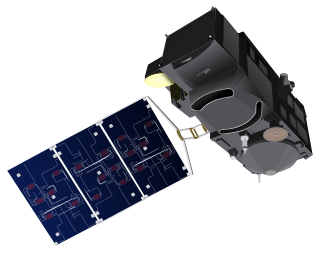
Sentinel-3 is an Earth observation satellite constellation developed by the European Space Agency as part of the Copernicus Programme.
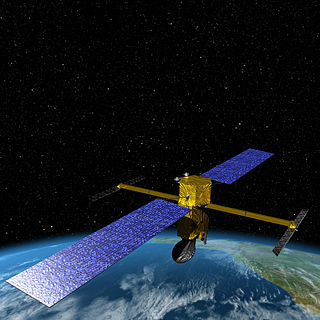
The Surface Water Ocean Topography (SWOT) Mission is a future satellite mission, jointly developed by NASA and CNES, the French space agency, in partnership with Canadian Space Agency (CSA) and UK Space Agency (UKSA). The objectives of the mission are to make the first global survey of the Earth's surface water and to observe the fine details of the ocean surface topography, and to measure how terrestrial surface water bodies change over time. While past satellite missions like the Jason series altimeters have provided variation in river and lake water surface elevations at select locations, SWOT will provide the first truly global observations of changing water levels in rivers, lakes and floodplains. In the world’s oceans, SWOT will also observe ocean circulation at unprecedented scales of 15–25 km, approximately an order of magnitude finer than current satellites, over the global oceans. Because it uses wide-swath altimetry technology, SWOT will almost completely observe the world's oceans and freshwater bodies with repeated high-resolution elevation measurements, allowing observations of variations.
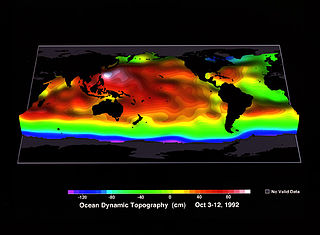
Ocean surface topography or sea surface topography, also called ocean dynamic topography, are highs and lows on the ocean surface, similar to the hills and valleys of Earth's land surface depicted on a topographic map. These variations are expressed in terms of average sea surface height (SSH) relative to the Earth's geoid. The main purpose of measuring ocean surface topography is to understand the large-scale ocean circulation.
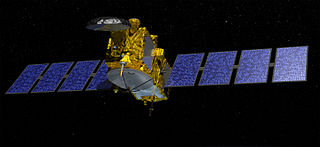
Jason-3 is a satellite created by a partnership of the European Organisation for the Exploration of Meteorological Satellites (EUMESTAT) and National Aeronautic and Space Administration (NASA), and is an international cooperative mission in which NOAA is partnering with the Centre National d'Etudes Spatiales. The satellites' mission is to supply data for scientific, commercial, and practical applications to sea level rise, sea surface temperature, ocean temperature circulation, and climate change.

SAC-D, also known as Aquarius after its primary instrument, is an Argentine Earth science satellite built by INVAP and operated by CONAE. SAC-D was launched from Vandenberg Air Force Base on 10 June 2011, with a planned mission life of five years. Due to a power system failure, the mission was ended on 8 June 2015.

SARAL or Satellite with ARgos and ALtiKa is a cooperative altimetry technology mission of Indian Space Research Organisation (ISRO) and CNES. SARAL will perform altimetric measurements designed to study ocean circulation and sea surface elevation. The payloads of SARAL are The ISRO built satellite with payloads modules, DORIS, Laser Retro-reflector Array (LRA) and ARGOS-3 data collection system provided by CNES was launched by Indian Polar Satellite Launch Vehicle rocket into the Sun-synchronous orbit (SSO). ISRO is responsible for the platform, launch, and operations of the spacecraft. A CNES/ISRO MOU on the SARAL mission was signed on Feb. 23, 2007.
W. Timothy Liu became a Fellow of the American Meteorological Society in the year 2000, a Fellow of American Association for the Advancement of Science in 2007, and most recently an American Geophysical Union Fellow (2011). By the end of 2008 he had published 145 refereed journal articles or reviewed book chapters, and has authored over 260 publications in total.
The annual cycle of sea level height describes the variation of sea level that occurs with a period of one year. Historically, analysis of the annual cycle has been limited by locations with tide gauge records, i.e., coastlines and some islands in the deep ocean, and by sparse records in the Southern Hemisphere. Since 1992, satellite-based altimeters have provided near global coverage of sea level variability, allowing for a more thorough understanding of the annual cycle both in the deep ocean and in coastal margins.
Anny Cazenave is a French space geodesist and one of the pioneers in satellite altimetry. She works for the French space agency CNES and has been deputy director of the Laboratoire d'Etudes en Geophysique et Oceanographie Spatiale (LEGOS) at Observatoire Midi-Pyrénées in Toulouse since 1996. Since 2013, she is director of Earth sciences at the International Space Sciences institute (ISSI), in Bern (Switzerland).
George Henry Born was an American aerospace engineer, Distinguished Professor, founder and Director Emeritus of the Colorado Center for Astrodynamics Research (CCAR) at the University of Colorado Boulder. He is known for his work in satellite navigation and precise orbit determination. He worked on various missions while at the Jet Propulsion Laboratory as well as navigation support for the Apollo program in the late 1960s while at Johnson Space Center.




